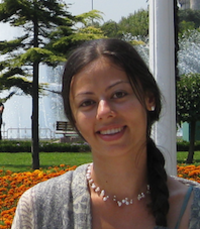Short bio
Nina Mirnig received her BA (2004), M.St. (2005) and D.Phil. (2010) in Oriental Studies/Sanskrit from Oxford University. After completing her graduate studies, she held a post-doctoral position at the Institute for Indian Studies at Groningen University, a Gonda Fellowship at the International Institute for Asian Studies in Leiden, and was a research associate at Cambridge University. She joined the Institute in 2015 as a postdoctoral research fellow in the Austrian Science Fund (FWF) projects "Visions of Community" (SFB F42-G18) and "Śivaliṅga Worship on the Eve of the Tantric Age" (P-27838-G15). In 2019 she was awarded the Austrian Science Fund Elise Richter Prize, leading a project on the religious, cultural and political landscape of early medieval Nepal (FWF V 755-G). In 2020, she was elected member of the Young Academy of the Austrian Academy of Sciences and since 2022 she has been serving as Member of the Board of Directors. Since 2023, she is Key Researcher in the Austrian Science Fund Cluster of Excellence Eurasian Transformations.
Her research interests include the literature, rituals, history and spread of early Śaivism and the Tantric traditions; religious, cultural and political connectivities across the Himalayas; the cultural history of early medieval Nepal; South Asian epigraphy; and the cultural context of ancient technologies, in particular irrigation. She has published several edited volumes and a monograph on early Śaiva Tantric death rites (Mirnig 2018) and is preparing a critical edition and translation of the early foundational Śaiva scripture Śivadharmaśāstra, chapters 1–5 and 9, including an introductory study on socio-religious aspects and devotional practices of Śaiva communities during this formative period. Her current project focuses on the reception and development of Sanskrit culture and Hindu traditions in early medieval Nepal, with special focus on the documentation and study of Sanskrit Licchavi inscriptions (c. 5th–8th c. CE) in the Kathmandu Valley. She is also engaged in developing collaborative approaches that combine text-based philological studies with archaeology, art history and heritage studies. In the FWF Cluster of Excellence Eurasian Transformations she leads several research trajectories on (1) Geographies of Power, (2) Communication and Mobility, and (3) Religious Identification.
At the University of Vienna she teaches courses on Śaivism, Tantra and South-Asian epigraphy. She is on the Editorial Board of the interdisciplinary journal Medieval Worlds, Member of the Commission of Publications (Publikationskommission) of the Austrian Academy’s Division of Humanities and the Social Sciences for the Austrian Academy of Sciences Press and member of the Executive Board of the De Nobili Research Library – Association for Indology and the Study of Religion (University of Vienna). Further, she is one of the contributing authors for the Dictionary of Technical Terms from Hindu Tantric Literature (Austrian Academy of Sciences Press).
Monograph
Nina Mirnig, 2018
Liberating the Liberated: Early Śaiva Tantric Death Rites. With Editions and Annotated Translations of Selected Passages of the Svāyambhuvasūtrasaṃgraha, Sarvajñānottara, Kiraṇa, and Jñānaratnāvalī. (BKGA 96.) Wien: VÖAW, 2018.
Edited volumes
Nina Mirnig, Marion Rastelli, Vincent Eltschinger (eds.), 2019
Tantric Communities in Context. (BKGA 99.) Wien: VÖAW, 2019 (download PDF [open access] or order online).
Natasja Bosma, Nina Mirnig (eds.), 2013
Epigraphical Evidence for the Formation and Rise of Early Śaivism. (Special Issue of the Indo-Iranian Journal 56:3/4.) Leiden: Brill, 2013.
Nina Mirnig, Peter Daniel Szanto, Michael Williams (eds.), 2013
Puṣpikā: Tracing Ancient India through Texts and Traditions. Contributions to Current Research in Indology. Oxford: Oxbow Books, 2013.
Selected articles
Mirnig, Nina; Rastelli, Marion, Lineages and Movements: The Worship of Viṣṇu, Śiva, and the Goddess. In: Adheesh Sathaye (ed.), A Cultural History of Hinduism in the Classical Age : 200 BCE–800 CE. London: Bloomsbury. (forthcoming 2024)
Mirnig, Nina; Acharya, Diwakar, A Rāṣṭrakūṭa king in the Kathmandu Valley: Re-assessing late Licchavi history in the light of a newly deciphered eighth-century inscription. Journal of the American Oriental Society. 2023.
Mirnig, Nina; Acharya, Diwakar, Licchavi inscriptions from Nepal: Historical significance in a cross-cultural context. Past, present, and future directions of research. Journal of Tibetology 25, pp. 138–162. 2023.
Mirnig, Nina; Rebay-Salisbury Katharina, Sustainability in archaeology and heritage preservation: the importance of context. Gingrich, Simone, Johannes Schmidt, Hannes Fellner, Maximilian Hartmuth (eds.), Akademie im Dialog – Forschung und Gesellschaft 4. Eds. Vienna: Austrian Academy of Sciences, pp. 27–36. 2023.
“Adapting Śaiva Tantric Initiation for Exoteric Circles: The Case of the Lokadharmiṇī Dīkṣā and its History in Early Medieval Sources“, in Śaivism and the Tantric Traditions: Essays in Honour of Alexis Sanderson, (eds) Dominic Goodall, Shaman Hatley, Harunaga Isaacson, Srilata Raman. Leiden: Brill, 2020.
“Rudras on Earth on the Eve of the Tantric Age: The Śivadharmaśāstra on creating Śaiva lay and initiatory communities“, in Tantric Communities in Context, (eds) Nina Mirnig, Marion Rastelli, Vincent Eltschinger. Vienna: Austrian Academy of Sciences Press, pp. 471–510. (2019).
“Umā and Śiva's Playful Talks in Detail (Lalitavistara): On the Production of Śaiva Works and their Manuscripts in Medieval Nepal”; together with Florinda De Simini. In The South Asian Manuscript Book. Material, Textual and Historical Investigations, (eds) V. Vergiani, D. Cuneo and C.A. Formigatti. De Gruyter: Berlin. (2017)
“Early Strata of Śaivism in the Kathmandu Valley: Śivaliṅga Pedestal Inscriptions from 466–645 CE,” in the Indo-Iranian Journal, Volume 59 4/4, Brill. (2016)
“Exploring ancient Pashupati: the results of preliminary surveys and excavations at Bhandarkhal 2014–2016”; Coningham, R.A.E., Acharya, K.P., Davis, C.E., Manuel, M.J., Kunwar, R.B., Hale, D., Tremblay, J., Gautam, D. and Mirnig, N., Ancient Nepal 192, pp. 28–51. (2016)
“Hungry Ghost or Divine Soul? Post-Mortem Initiation in Medieval Śaiva Tantric Death Rites,” in Ultimate Ambiguities. Investigating Death and Liminality, (eds) Peter Berger and Justin Kroesen. Berghahn Books. (2015)
“Favoured by the Venerable Lord Paśupati. Tracing the Rise of a new Tutelary Deity in Epigraphic Expressions of Power in Early Medieval Nepal,” in the Indo-Iranian Journal, Volume 53, 3/4, Brill. (2013)




